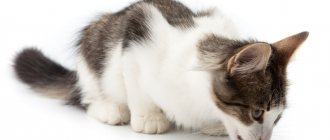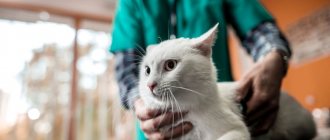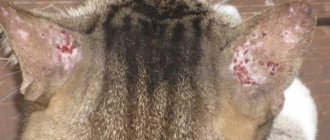July 17, 2020
Pyometra - purulent inflammation of the uterus - is one of the most common diseases of the reproductive system of cats, and also one of the most dangerous.
This disease is caused by a bacterial infection and occurs in acute or chronic form with the accumulation of purulent exudate in the uterine lumen and can have a variety of clinical manifestations.
With the progression of symptoms and the absence of timely treatment, pyometra leads to peritonitis, which occurs due to rupture of the uterine wall under the influence of a large amount of accumulated purulent exudate.
Who can get pyometra?
Cats are less likely to develop pyometra than dogs. This may be due to less progesterone being released. Unfortunately, due to the lower prevalence of the disease in cats, fewer factors are known to contribute to or prevent the development of pyometra in cats.
However, it is known that older animals are most susceptible to the disease; the risk of the disease increases significantly after 7 years, the average age of onset of pyometra is 5.6 years. Despite this, pyometra can also occur in very young animals - even a ten-month-old cat can get sick.
Only castration can completely prevent the development of purulent inflammation of the uterus. A cat’s history of childbirth, according to research, also does not in any way protect it from the disease.
It is also reliably known that previous hormonal therapy associated with the intake of progesterone contributes to the development of pyometra, therefore the use of drugs to suppress sexual estrus in animals is extremely undesirable.
Causes
Festering eyes are not an independent disease, but only a symptom, and veterinarians identify many causes.
One of the most common is ophthalmological pathologies:
- Conjunctivitis is a harmless disease that is an inflammation of the mucous membrane of the eyes.
- Keratitis is damage to the cornea due to trauma, burns with chemicals, infections, and allergies.
- Blepharitis is an inflammation of the edges of the eyelids caused by bacteria.
- Injuries to the mucous membrane. Minor damage heals on its own. In large wounds caused by sharp objects (claws, branches), an inflammatory process with suppuration of the eyes may occur.
Often kittens are born with pathologies of the organ of vision. The defects cause watery eyes and discharge of pus. So, the baby may lack a lacrimal punctum, the lower eyelid may turn inward, eyelashes may grow in several rows, etc. Other causes of suppuration include:
- poor quality care, lack of hygiene;
- unbalanced diet;
- decreased immunity;
- colds caused by drafts and hypothermia;
- allergy;
- atopic dermatitis;
- chlamydia;
- heredity.
The eyes can fester in any animal, regardless of gender and age. Breeds such as Scottish, British, and Persian are especially susceptible to this pathology. This is explained by the anatomical features of the skull.
Connection with hormones
The etiology of purulent inflammation of the uterus is associated with changes in the titer of sex hormones during the reproductive cycle. Pyometra is called a progesterone-dependent disease, it manifests itself in a phase of the cycle in which the concentration of progesterone is high and estradiol is low. This phase is diestrus - the end of estrus and the period immediately following it until the stage of ovarian rest.
Progesterone promotes the growth of the uterine glands, an increase in the amount of their secretion, the closure of the cervix, a decrease in the number and intensity of its contractions, which creates the ground for the subsequent proliferation of microflora and the development of the disease. Progesterone also mediates the pathological proliferation of endometrial glands and the formation of cysts, thus causing glandular cystic endometrial hyperplasia, a disease that often precedes and accompanies pyometra.
No less important is the second factor that causes purulent inflammation of the uterus - a bacterial infection. During estrus and shortly after its end, the internal environment of the cat's uterus is optimal for a possible pregnancy, but also for the growth of microorganisms due to the presence of a large amount of uterine gland secretion and suppression of the immune system. And when pathogenic or conditionally pathogenic microorganisms enter the uterus, inflammation begins.
Bacteria that causes pyometra
The most common bacteria that cause the development of pyometra are three genera:
- Escherichia (most often the bacterium Escherichia coli, also called “Escherichia coli”), is isolated from the affected uterus.
- Streptococcus (streptococci).
- Staphylococcus (staphylococcus).
Bacteria and their metabolic products, such as various toxic compounds, begin to circulate in the body, causing inflammation in various organs and systems, and can lead to fever, tachycardia, tachypnea (rapid breathing), shock and failure of internal organs.
Pyometra is characterized by an effect on the entire body of the animal; according to statistics, a septic process was detected in 86% of cats with pyometra.
Symptoms of pyometra in cats
Clinical symptoms of pyometra usually appear between 2 and 4 months after the end of estrus (but can appear at any other phase of the cycle) and can be varied.
Most often, mucous, purulent, and bloody discharge from the loop occurs, but they may not appear in closed type pyometra (in cats in 40% of cases). In this case, the cat will develop general symptoms indicating intoxication of the body and damage to various organs and systems.
The most classic symptoms are: exhaustion, depression, frequent urination, thirst, rapid heartbeat and rapid breathing, weak pulse, change in color of visible mucous membranes. Less common are fever, dehydration, abdominal tenderness, vomiting, diarrhea, and changes in the cat's gait.
Purulent, bloody, or yellow discharge
Bloody, purulent or yellow vaginal discharge in a cat almost always indicates the development of inflammation. Bloody discharge in a cat during the postpartum period is considered normal and is called lochia. They can be pinkish, dark brown or almost black. The duration of lochia is from 2 to 3 weeks. Normally, discharge after childbirth should not have an unpleasant odor.
It is important to note that during the onset of the heat period, cats, unlike dogs, do not experience bleeding. Therefore, if an animal intensively licks the vulva area, and droplets of blood are visible on the bedding, it is necessary to contact a veterinary hospital for advice as soon as possible.
Yellow or white discharge is normal before labor begins. A day or several hours before birth, the owner may notice the appearance of clear, whitish or greenish discharge from the loop. Discharge that does not go away for a long time and has an unpleasant odor is a signal of the development of pathology. You cannot do without the help of a veterinarian. When examined by a specialist, the female is not only given a clinical examination, but also prescribed a number of laboratory tests. An obligatory point in making a diagnosis is ultrasound diagnostics.
Among the pathological causes that provoke the appearance of specific exudate from the vagina in a cat are the following:
- Pyometra is a dangerous pathology caused by purulent-necrotic inflammation in the uterine cavity. In the open form of pyometra, exudate is released, initially cream-colored, then green, yellow, bloody with impurities of pus. In some cases, conservative treatment is carried out, which is effective in the initial stages of the disease. In case of advanced pathological process, it is recommended to perform extirpation of the uterus and appendages.
- Hematometra is a disease characterized by the accumulation of a large amount of blood in the uterus against the background of hemorrhage, provoked by an advanced form of endometritis or mechanical damage. Symptoms of hematometra in a cat are bloody discharge from the loop, liquid or in the form of clots, and have an unpleasant odor. Pathogenic microflora often joins, which leads to the appearance of pus.
- Hydrometra is a pathological process that occurs against the background of other diseases, for example, endometritis that is not treated in a timely manner. It is characterized by an increased accumulation of serous exudate in the uterine cavity.
- Endometritis is a commonly diagnosed disease in unsterilized cats. Pathology occurs as a result of the development of inflammation on the inside of the uterine layer. The disease can occur in both acute and chronic forms. The discharge in the initial stages of endometritis is cloudy, yellowish, and has a repulsive odor. Endometritis does not pose a direct threat to the life of a cat, but it is fraught with the development of complications in the absence of therapy.
Before contacting a veterinary clinic, the owner should carefully examine the type of discharge, its intensity, smell and color. This will help the doctor collect a medical history to make an accurate diagnosis. A number of important studies are carried out in the clinic, including:
- general clinical blood test;
- blood biochemistry;
- bacterial culture of vaginal exudate samples to determine the sensitivity of microflora to antibiotics;
- scraping for cytological examination;
- ultrasound diagnostics of the abdominal organs.
In some cases, it is recommended to conduct serological tests for herpes and brucellosis, and study the functioning of the renal system (to determine possible concomitant pathologies).
If the discharge that appears from the vaginal area in a female is physiologically caused, therapy is not carried out. In clinical veterinary practice, there have been cases of vaginitis occurring in young cats. After going through the first heat or undergoing a sterilization procedure, vaginitis disappears on its own.
Pathological vaginal discharge requires concentration from a specialist to make a diagnosis and prescribe treatment. Depending on the type of pathology and the degree of neglect, treatment will vary.
If a cat has an infection of the reproductive system with damage to the walls of the uterus, a foreign body is found in the birth canal, or malignant tumors are diagnosed, surgical treatment is prescribed. Surgical treatment is also carried out when diagnosing congenital anomalies in the structure of the ureter and the walls that form the vaginal opening.
Purulent discharge caused by the attachment and development of pathogenic bacterial microflora is stopped with the help of antimicrobial agents. A course of antibiotic therapy is prescribed, the dosage and treatment regimen of which is determined by the veterinarian.
If disorders in the blood clotting system are diagnosed, corrective treatment is carried out. In some cases, when the cause of a cat’s discharge from the loop is a tumor, not only surgery is performed, but chemotherapy is also prescribed.
How is the diagnosis made?
Making a diagnosis of “pyometra” is not difficult in classic cases based on history, examination, and physical examination, but there are also difficult cases with an atypical picture of the disease.
To make a diagnosis, the cat will need to be examined: blood tests, an ultrasound examination of the abdominal cavity, and an x-ray may be required.
A clinical blood test usually shows a high number of immune cells: leukocytes, monocytes, neutrophils and anemia; a biochemical blood test indicates kidney damage.
An X-ray examination can show the size of the cat's uterus, and an ultrasound can also help detect fluid in the organ cavity. If research data is available, the diagnosis will be final and reliable. Additional diagnostics are almost never required.
What to do
Abnormal bleeding like the ones described can be very alarming, but remember to remain calm. Just be aware that if this happens, contact your veterinarian immediately because different treatments will be needed depending on the cause. Additionally, some diseases that cause bleeding can be fatal if not treated promptly.
Also remember that you should never self-medicate your cat or ignore his symptoms of illness or discomfort.
This article is for informational purposes only; we cannot prescribe veterinary treatment or make any diagnosis on the site. We recommend that you take your pet to the vet if he has any problems or discomfort.
Treatment of pyometra
There are two main treatment strategies for pyometra: surgical and conservative.
Surgical treatment is the most common and safest method: it is guaranteed to stop the development of the disease and remove the source of infection from the cat’s body.
The operation to remove the ovaries and uterus (ovariohysterectomy), which is performed for purulent inflammation of the uterus, begins after stabilizing the patient with the help of an intravenous infusion, carried out to relieve intoxication and restore fluid balance in the body.
During surgery, monitoring is aimed at maintaining normal blood circulation, gastrointestinal function, maintaining breathing and the required depth of anesthesia. The removal of the uterus is carried out very carefully to prevent its contents from entering the abdominal cavity. The bladder can be emptied if necessary by puncturing its wall (cystocentesis).
Postoperative period
After surgery, the cat should be monitored for 1-2 days in a hospital or at home. Treatment is prescribed in the form of antimicrobial and supportive therapy. As a rule, the recovery period lasts 2 weeks, after which the consequences of the disease and surgery disappear.
In the postoperative period, it is important to strictly follow all doctor’s instructions. Your cat may be prescribed a variety of medications, including injections (shots) and infusions (droppers). Owners will need to monitor the condition of the cat, inspect the seam, ensure that it remains dry and clean, and treat it if necessary. After surgery, it is important to prevent the animal from hypothermia, not to expose it to stress, and to feed it regularly.
The prognosis for surgery is quite favorable and depends on the age of the cat, the presence of concomitant pathologies and, first of all, the severity of the disease. Mortality during surgical treatment of pyometra ranges from 3 to 20%. A cat with uterine rupture and subsequent peritonitis has a 57% chance of dying during and after surgery, so it is so important to pay attention to the first signs of illness in the animal.
Caring for your cat after surgery
After surgery (removal of the uterus and ovaries), your pet needs appropriate care. When carrying out care you must:
- Put a post-operative blanket on the cat (sometimes this is done in a veterinary clinic) so that the cat does not chew or lick the post-operative stitches.
- Inspect the surgical suture daily. If redness or inflammation appears at the suture site, the cat must be taken to the veterinary clinic where the operation was performed.
- Despite the fact that the cat may lose its appetite after surgery, the cat should have free access to water.
- After surgery, the cat is prescribed a special veterinary diet (pates) or chicken broth with chopped meat. The cat must be fed soft and semi-liquid food.
- If there is any deterioration in the general health of the cat, it is necessary to show it to a veterinarian.
Drug treatment of pyometra
Abroad, drug treatment of pyometra is increasingly being used to replace ovariohysterectomy in the absence of pronounced symptoms of the disease and the need for emergency treatment. The drugs most often used for therapy are aglepristone, a progesterone antagonist that blocks progesterone receptors in the uterus, and cloprostenol, a luteolytic agent aimed at stopping the production of progesterone by the corpus luteum.
At the same time, antibiotic therapy is carried out to eliminate bacteria that create an inflammatory process in the uterus and urinary system. It should be noted that conservative treatment of pyometra is criticized by the veterinary community, primarily due to the high risk of relapses at the end of the course of treatment (from 10 to 30%), therefore the most reliable way to cure purulent inflammation of the uterus is still surgical. Moreover, it is the only possible one if the animal is in serious condition.
It is important to remember that drug treatment can only be chosen if the cat is young and does not have concomitant diseases and general symptoms of purulent inflammation of the uterus. The main advantage of such treatment is the preservation of the cat’s reproductive function, however, despite the normal course of pregnancy and childbirth, pyometra can return at any time. This treatment strategy is only advisable for animals of exceptional breeding value or if the cat cannot be subjected to surgery.
Discharge from the urethra: treatment
The treatment method in this case directly depends on the cause that caused such a phenomenon as pathological discharge from the urethra. It is important to understand that self-treatment can cause complications and is therefore unacceptable. Discharge can occur due to the penetration of various types of pathogens, which must be combated using different methods. Most often, drug therapy involves the use of antibiotics, but their selection should be carried out on an individual basis. As a rule, the following means are used:
| Group | When to use | Name |
| Antibacterial | STD | "Azithromycin", "Amoxiclav" |
| Uroseptics | Urethritis | A solution of chlorhexidine and collargol |
| Sulfanilamide | When bacteria that cause inflammation are detected | "Doxycycline" |
| Antimicrobial | Trichomoniasis | "Metronidazole" |
In addition, patients are recommended to wash their genitals with decoctions of knotweed, chamomile, calendula or special antiseptic solutions. Warming applications and electrophoresis give good results.
Prevention of pyometra
Pyometra is an extremely dangerous disease that can potentially lead to death if left untreated, so if an unneutered cat shows symptoms of the disease, you should contact your veterinarian immediately.
You also need to remember about the only way to prevent purulent inflammation of the uterus - castration. Timely castration of non-breeding animals can save the cat and its owners from many unpleasant experiences associated with the treatment of pyometra, and possibly even the death of the pet.
Back











